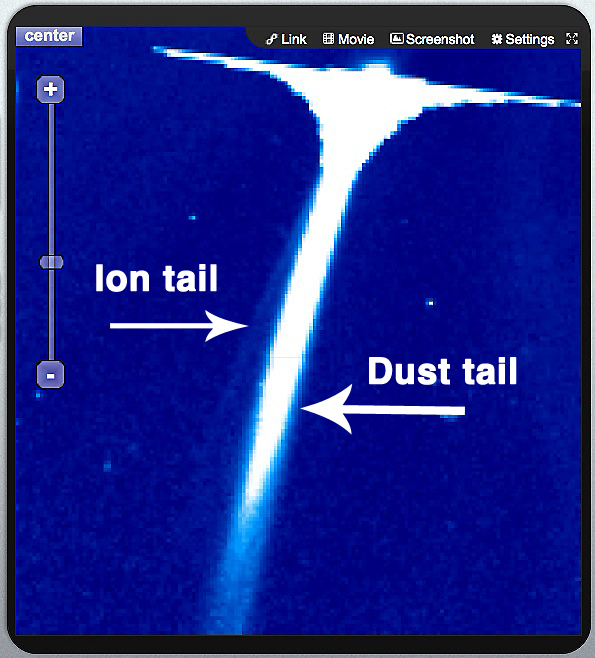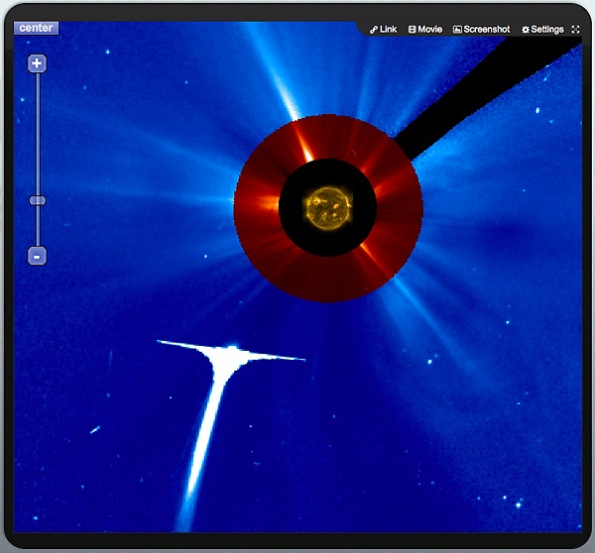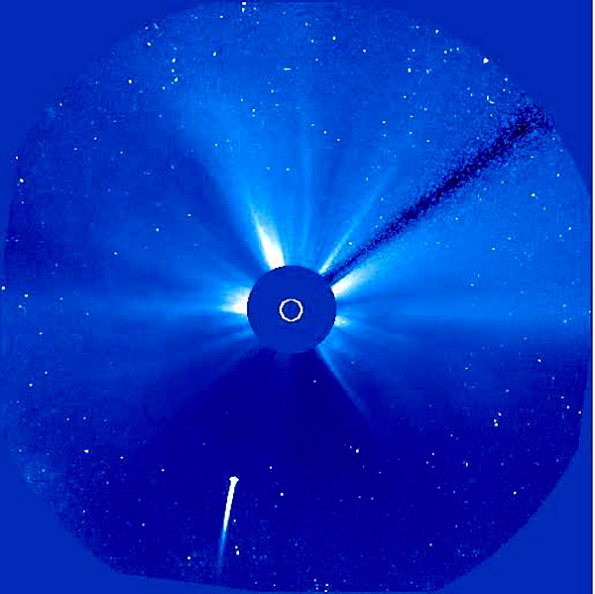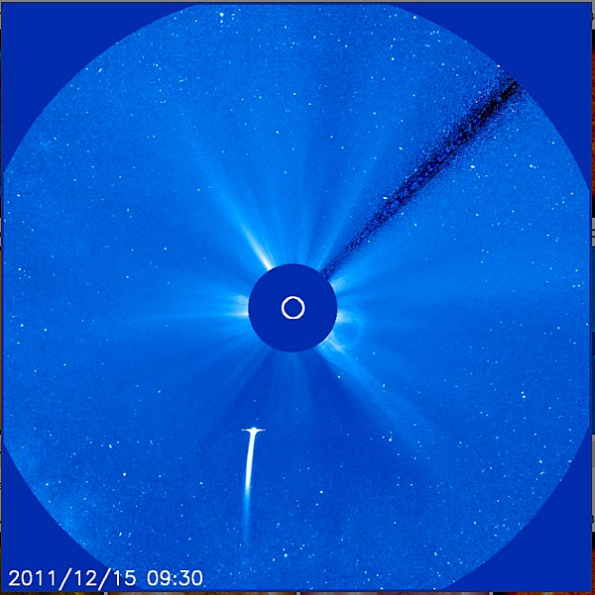Archive
Lovejoy gets a big head and grows an extra tail: up to the minute details on the death of a comet

3:52 pm (EST) Thursday
I just got off the phone with Jack Ireland and Alex Young, solar scientists who work at Goddard and are following Comet Lovejoy’s demise closely. Look what’s happening to the comet!
First, see how bulbous and weird the head of the comet is? That’s because the incredible brightness of the comet’s head is overwhelming the detectors on the SOHO satellite. The photons are “bleeding” out to form that cross-like pattern.
It gets interestinger and interestinger: Two distinct tails have formed. “The thick white tail is primarily dust breaking away from the comet nucleus,” Ireland explained in an email. “It’s the Sun’s radiation and solar wind that knocks the material off the comet nucleus.”
But to the left of the dust tail, do you see that faint wispy second stream? That is a tail of charged particles (ions) being deflected to the side by the magnetic field carried by the solar wind.
The coolest thing is that this is all happening right now.
Word is that the comet will pass behind the sun at around 7 pm tonight (EST). It may or may not come out the other side in its orbit. It depends how massive the comet is and how long it survives the pounding of the solar wind.

_____________________________________________________________________________________________________
OH AND DID I MENTION? All opinions and opinionlike objects in this blog are mine alone and NOT those of NASA or Goddard Space Flight Center. And while we’re at it, links to websites posted on this blog do not imply endorsement of those websites by NASA.
w3counter(39986);
Comet Lovejoy plunges into the sun!
3:52 pm (EST) Thursday
I just got off the phone with Jack Ireland and Alex Young, solar scientists who work at Goddard and are following Comet Lovejoy’s demise closely. Look what’s happening to the comet!
First, see how bulbous and weird the head of the comet is? That’s because the incredible brightness of the comet’s head is overwhelming the detectors on the SOHO satellite. The photos are “bleeding” out to form that cross-like pattern.
It gets interestinger and interestinger: Two distinct tails have formed. It gets interestinger and interestinger: Two distinct tails have formed.
“The thick white tail is primarily dust breaking away from the comet nucleus,” Ireland explained in an email. “It’s the Sun’s radiation and solar wind that knocks the material off the comet nucleus.”
But to the left of the dust tail, do you see that faint wispy second stream? That is a tail of charged particles (ions) being deflected to the side by the magnetic field carried by the solar wind.
The coolest thing is that this is all happening right now.
Word is that the comet will pass behind the sun at around 7 pm tonight (EST). It may or may not come out the other side in its orbit. It depends how massive the comet is and how long it survives the pounding of the solar wind.

Set the controls for the heart of the Sun, Lovejoy!
As tweeted minutes ago earlier by Phil Plait on Bad Astronomy, Comet Lovejoy has begun it’s searing plunge into the sun. Here’s a still image from the video Phil tweeted out:

And here is the image of the comet from NASA’s The Sun Today site:

Go to Helioviewer.org to find out all the details about Lovejoy and how you can observe it!
While you’re at it, check out the VIDEO on Helioviewer.org of Lovejoy in mid-plunge.
_____________________________________________________________________________________________________
OH AND DID I MENTION? All opinions and opinionlike objects in this blog are mine alone and NOT those of NASA or Goddard Space Flight Center. And while we’re at it, links to websites posted on this blog do not imply endorsement of those websites by NASA.
// < ![CDATA[
//
&amp;lt;/p&amp;gt; &amp;lt;div&amp;gt;&amp;lt;a href=”http://www.w3counter.com” mce_href=”http://www.w3counter.com”&amp;gt;&amp;lt;img src=”https://www.w3counter.com/tracker.php?id=39986″ mce_src=”https://www.w3counter.com/tracker.php?id=39986″ style=”border: 0″ mce_style=”border: 0″ alt=”W3Counter” /&amp;gt;&amp;lt;/a&amp;gt;&amp;lt;/div&amp;gt; &amp;lt;p&amp;gt;